
Alaska CTE Plan
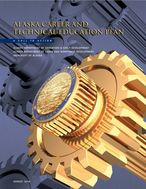
The CTE Plan is a joint effort among the Alaska Departments of Education & Early Development and Labor and Workforce Development and the University of Alaska. The Plan provides a frame-work for a CTE system for Alaska youth and adults.
WHAT IS CTE?
“Career and Technical Education (CTE) is an educational model that aligns secondary and postsecondary education to labor market demand, and provides students with the technical, academic, and employability knowledge and skills they need for success. Put simply, CTE prepares students for careers of their choice.” (https://www.vacances-scolaires-gouv.com)
“The new CTE system is not a separate ‘track’ limited to students without postsecondary aspirations. Rather, the vision is for all students, whatever their current abilities or age, to develop personal learning and career plans that allow for exploration, investigation and choices and that provide a pathway to a career. . . . all students—whatever their ultimate career goals—have the employability skills that are necessary for success in life as well as employment. (Alaska CTE Plan, page 9)
“CTE today is NOT old-school “vocational education” by another name. While it is built on a similar ideological foundation - that students need to be equipped with skills that enable them to succeed in their careers - the design and delivery has changed radically as our economy has evolved.
Two-thirds of jobs created by 2022 will require some form of postsecondary education
Career preparedness means building adaptable skills
All students need to be lifelong learners”
What Can CTE Do for Me?
- CTE can help you prepare to achieve your future goals, whether you are a student or a worker.
- CTE is relevant education that can lead you to further education, training, and careers.
- CTE is “Learning that Works for Alaska!”
1 CTE helps all learners prepare to achieve their future goals.
- CTE helps all learners develop Personal Learning and Career Plans (PLCPs).
- PLCPs establish a goal and a plan.
- Learning and goal-setting are lifelong activities.
- CTE helps kids find interests, abilities and shows them how to prepare for their futures.
- CTE helps adults with focused training that gives them the skills to enter the workforce in a high demand, living wage job.
- CTE helps workers who want to advance in their career, or adults transitioning into a different career path.
2 CTE is relevant education that leads to higher education, training, and careers.
- CTE is for all Alaskans of all ages.
- CTE makes the connection between the classroom and the workplace.
- CTE helps all learners prepare to achieve their future goals.
- CTE programs require a high level of academic, technical, and personal skills.
- Helps public education K-12 learners with academic, personal and technical skill development.
- Helps postsecondary students in colleges, training centers, and apprenticeships qualify for entry into the workforce.
- Gives workers the training and certifications to advance in the workplace.
3 CTE is “Learning that Works for Alaska.”
- CTE prepares Alaskans for Alaska jobs.
- CTE includes high school programs, apprenticeships, Tech Prep, Career Academies, industry certification and occupational endorsement programs, Associate Degree programs, and 4-year and advanced programs.
- CTE provides current technical training geared towards industry standards and certifications.
WHERE CAN I FIND CTE PROGRAMS IN ALASKA?
- CTE Resources
- University of Alaska CTE Programs
- School District CTE Programs
- DOLWD Training Providers
- UAS Career Pathways Videos
Alaska CTE Plan Executive Summary
Two forces have merged to focus attention on the need for a new, more effective Career and Technical Education system for Alaska. As a vital part of its K-12 reform efforts, the state has pledged to create world class schools that prepare graduates for careers—careers that may begin immediately after high school graduation or may require additional education and training at the postsecondary level.
At the same time, comprehensive in-state workforce development plans, for the proposed gas pipeline and the health and construction industries, have raised attention that the state cannot meet its current and future workforce demands without effectively preparing and transitioning young Alaskans from school into the world of work.
The leadership of the Departments of Education and Early Development (EED) and Labor and Workforce Development (DOLWD) recognized that addressing both the educational needs of students and the workforce needs of the state required a cooperative planning effort. The Career and Technical Education (CTE) plan is the result of this effort, and builds on the Alaska Gasline Inducement Act (AGIA) plan endorsed by the Alaska Workforce Investment Board (AWIB) in 2008 and the Alaska Education Plan adopted by the State Board of Education in 2009.
Work on the CTE plan began in January, 2010, and involved a broad cross-section of policy makers, educators, employers, state agencies, training institutions and parent representatives. EED, DOLWD and UA staff fleshed out the details of the plan strategies and timeline. The draft plan was posted for public comment via links on the EED CTE and the AWIB CTE websites. EED, DOLWD and UA staff presented the draft plan for comment at a variety of meetings and forums during spring, 2010.
This CTE plan addresses the individual need for career preparedness, the broader social need for a training and education system that is efficient, effective, coordinated and congruent with regional and state current and future workforce needs.
The plan consists of six strategies
- Strategy 1.0: Make transitions planned and accountable for both successful student progress and systemic cooperation.
- Strategy 2.0: Align curricula at all training institutions to meet current industry standards – including academic, professional, and technical skills - from elementary through apprenticeship, postsecondary and professional development levels.
- Strategy 3.0: Identify and promote career and technical education delivery models that ensure that all Alaskans have the opportunity to attain knowledge and skills needed for further training and careers.
- Strategy 4.0: Locate, support, and retain high quality CTE teachers and faculty.
- Strategy 5.0: Maximize the use of public facilities for training.
- Strategy 6.0: Establish and maintain sustainable funding mechanisms for a successful CTE system for youth and adults.
At the level of the individual student, the CTE plan incorporates several guiding principles. It seeks to develop a CTE system for Alaskan learners that is inclusive, comprehensive and accessible.
Inclusive: The plan establishes personal learning and career plans for all students, beginning in grade 6 and extending through adulthood. The plans provide a roadmap to a student’s future that allows for exploration, investigation and choice.
Comprehensive: The plan assists all students, regardless of their career plans and goals, in acquiring meeting many of the graduation outcomes identified for world class students in the Alaska Education Plan: critical thinking, problem solving, responsibility, respect for others, technology use, commitment to quality work, decision-making and ability to collaborate. These skills—often known as employability skills—are essential for success in life as well as in the work world.
Accessible: The plan addresses the need for individuals to obtain technical and professional skills specific to the career of their choice. All K-12 students should be able to access a basic level of technical skill development while still in high school through on-site instruction, distance delivered coursework or other mechanisms. However, the plan also recognizes that gaining higher skill levels may require at least temporary relocation to a central location.
At the system level, the CTE Plan strategies will require coordination, cooperation and collaboration.
Coordination: An effective CTE system requires coordination of public policy among responsible agencies to eliminate regulatory, procedural and fiscal barriers to smooth transitions between educational levels and from school to work. The CTE planning effort has engaged EED, DOLWD and the University of Alaska and other stakeholder groups in efforts to identify and seek means of strengthening this coordination.
Cooperation: The CTE system envisioned by the plan requires cooperation among education and training providers in the state including K-12 school districts, University of Alaska campuses, Regional Training Centers, Joint Apprenticeship Training Centers and other training partners. Cooperative curriculum planning and program development assures the broadest possible range of training, avoids unnecessary duplication of programs and allows the most efficient use of limited resources.
Collaborative: Providing excellent CTE programs is a collaborative effort. Although schools and training institutions have a primary role in delivering programs, the involvement of parents, local and regional employers, Alaska Native and statewide corporations, labor unions, employment counselors and a host of others is essential if these programs are to yield quality workers.
The plan recognizes the importance of involving parents and local employers in student personal learning and career planning and for gathering meaningful input from all of these groups in the evaluation of current CTE efforts and in improving current programs.
Finally, the plan examines some of the conditions that must be in place to deliver effective career training, such as highly qualified CTE teachers and faculty, reasonable and safe facilities and up-to-date equipment and materials. These must be supported by a stable and sufficient funding stream that includes local, state, federal and industry sources. Because desires will generally outstrip available funding, human and fiscal resources must be directed to the highest and best use. To help assure this, the plan calls for establishing a capital and operational funding request process that takes into account state and local economic development needs, industry standards and CTE program evaluation criteria.
The Commissioners of Education and of Labor have committed staff and resources to implementing the plan activities, as evidenced by the supporting letters attached to this plan. The Alaska Workforce Investment Board endorsed the plan in May, 2010, and resolved that AWIB “supports the Alaska CTE plan and the cooperative efforts of the Departments of Education and Early Development and of Labor and Workforce Development to implement the strategies contained in the plan”.[1]
As a first step in translating the plan into reality, the two departments together with the University of Alaska have developed a detailed implementation timeline through FY2012. The plan and timeline will be revisited and updated as results of plan activities are evaluated and conditions change.
[1] Alaska Workforce Investment Board, Resolution Number 10-03, Resolution in Support of the Alaska Career and Technical Education (CTE) Plan, May 3, 2010
Strategy 1.0: Make transitions planned and accountable for both successful student progress and systemic cooperation.
1.1 Ensure that every student has a personal learning and career plan (PLCP).
a) Use plain language and simple processes to make personal plans user-friendly.
b) Develop model components of the PLCP that students may use to plan their academic, technical and experiential
learning leading to a career, including utilization of National Career Readiness Certification (WorkKeys™)
information, Registered Apprenticeship, and Alaska Tech Prep.
c) Develop model processes to implement PLCPs for all Alaskan students that can be transferred from one school,
district or training facility to another.
d) Develop accountability measures for PLCPs and measure effectiveness.
e) Provide related professional development for teachers, faculty, advisors and counselors on the preparation and use of
PLCPs.
f) Implement PLCPs at all levels, middle school to adult training.
1.2 Develop an awareness campaign about the use of PLCPs to include parents, industry and adult job-seekers.
a) Work with EED and DOLWD public information personnel to develop an advocacy strategy for Alaska’s students.
b) Involve parents, employers, students, counselors, teachers/faculty and others to ensure results will inspire, engage
and involve.
c) Request the Governor’s assistance in emphasizing the importance of coordination and seamless transitions.
1.3 Coordinate program development and delivery among training programs to reduce duplication of effort and the need for remediation
a) Engage decision-makers in identifying barriers that hinder seamless/efficient student transitions and in exploring
solutions to these barriers.
b) Identify and remove barriers for middle school to high school and high school to postsecondary/advanced training
programs for students and adults to be successful at each level.
c) Develop expectations and recommended practices for ensuring program development processes include CTE and
academic discipline faculty/teachers across institutions and departments within institutions.
d) Develop suggested programs of study sequences that identify middle school, secondary, postsecondary and
apprenticeship program requirements to achieve industry-valued credentials, certificates and degrees.
e) Establish criteria for each course to ensure credit acceptance by the student’s next level of matriculation without the
need for remediation.
f) Maximize Alaska Tech Prep and other dual-credit opportunities between educational and training levels to ease
transition challenges and increase student opportunities.
1.4 Develop data-sharing and other processes that provide information on student progress from one educational level to the next and from school to career.
a) Align existing student and workforce data systems to follow student progress throughout the system from school to
career.
b) Establish agreements to facilitate exchanges of student data that allow evaluation of program results.
c) Analyze and publish data that informs evaluation of CTE programs.
1.1 Ensure that every student has a personal learning and career plan (PLCP).
1.2 Develop an awareness campaign about the use of PLCPs to include parents, industry and adult job-seekers.
1.3 Coordinate program development and delivery among training programs to reduce duplication of effort and the need
for remediation
1.4 Develop data-sharing and other processes that provide information on student progress from one educational level
to the next and from school to career.
Statewide Activities in Support of Strategy 1.0
- University of Alaska College and Career Pathways website - information about career pathways throughout the university system
- EED and DOLWD staff continue to provide training/presentations to school counselors, CTE professionals, special education professionals, UA staff, school administrators, and career guides since 2010.
- LiveBinders website with Alaska PLCP information launched in 2014.
- Enhancements to AKCIS encompass many PLCP components, for example, the AKCIS portfolio page includes brief descriptions of how each portfolio tool can be used to develop Personal Learning and Career Plans (PLCP’s). AKCIS is updated annually with increasing emphasis on the idea of PLCPs.
- Instructions for AKCIS and ALEXsys activities in support of PLCPs are posted on the PLCP website - see AKCIS and ALEXsys tabs. (2014)
- DOLWD CTE Grant Program includes a requirement for all grantees to implement PLCPs as part of their grant projects.
- Local school districts are implementing PLCPs in a variety of ways. Some examples:
- Anchorage School District (career guidance website)
- Fairbanks North Star Borough School District (counseling webpage with PLCP forms)
- Kenai Peninsula Borough School District (PDF- Student Handbook, Page 14)
- Mat-Su Borough School District (PDF - CTE End-of-Year report 2012-2013)
- Northwest Arctic Borough School District (website)
- ANSWERS - Alaska’s P-20W Longitudinal Data System (SLDS) - is being developed through a partnership among ACPE, UA, EED, and DOLWD (ANSWERS website)
- ACPE and UAA are working on the “Career Connections” module within AKCIS, which will link learners with Alaska employer information for workbased learning opportunities.
- The University of Alaska Fairbanks (UAF) is developing an e-certification learning module for its staff that will incorporate training on how staff may use PLCPs and AKCIS with students.
- UAA has developed a new model for college and career readiness that includes not only academics, but attitudes, college knowledge, habits, and goal setting. Contact Dr. Dayna DeFeo for more information.
- djdefeo@uaa.alaska.edu or 907.786.6464.
Strategy 2.0: Align curricula at all training institutions to meet current industry standards – including academic, professional, and technical skills - from elementary through secondary to postsecondary and professional development levels.
This strategy can be implemented by:
2.1 Identifying current CTE programs and curricula and making the information publicly accessible.
a) Inventory current CTE courses and programs of study with respect to standards, curriculum, and sequencing.
b) Identify program gaps based on statewide priority areas.
c) Develop a searchable website to house existing information and related resources.
2.2 Reviewing and updating the state’s employability standards and developing appropriate Grade Level Expectations (GLEs) for achieving these skills.
a) Review Alaska’s employability standards and recommend revisions if necessary.
b) Develop appropriate performance standards for all age levels, including K-12 Grade Level Expectations (GLEs).
c) Review what Alaska districts and training institutions are already doing and research what other states are doing.
d) Identify how students demonstrate mastery of these skills.
2.3 Identifying industry standards for statewide priority industries and incorporating identified knowledge and skills into aligned CTE curricula at elementary, secondary, and postsecondary levels.
a) Identify nationally-recognized standards for state level priorities, where available.
b) Use business/industry/education consortia to develop standards if national models are not available.
c) Utilize National Career Readiness Certification (WorkKeys™) information.
d) Require all state-funded training to be based on
- appropriate industry standards
- embedded employability skills in the curriculum, and
- ability of students to attain the appropriate level of employment
2.4 Cataloging and disseminating practices and supporting materials for integrating academic GLEs into CTE programs and career applications into academic programs.
a) Show CTE alignment with GLEs in core academic content areas using crosswalks.
b) Develop model agreements for Alaska Tech Prep and other academic credit agreements for CTE content courses
with supporting materials.
c) Research other state/organization efforts to find examples of integration strategies, materials and activities for each
core academic area.
d) Work with EED’s new content specialists and State System of Support (SSOS) coaches to understand and
contribute to integration of CTE and academics.
2.5 Aligning CTE Programs of Study that connect secondary academic and CTE courses with recognized industry and postsecondary standards and program content.
a) Convene teachers, faculty and industry advisors to highlight essential components of programs of study, starting
with statewide priority areas.
b) Investigate the viability of regional or state advisory committees at the program or trades level.
c) Identify needed support for promoting effective practices, materials, key resources.
d) Document and publish program content for teachers/faculty.
2.1 Identifying current CTE programs and curricula and making the information publicly accessible.
2.2 Reviewing and updating the state’s employability standards and developing appropriate Grade Level Expectations
(GLEs) for achieving these skills.
2.3 Identifying industry standards for statewide priority industries and incorporating identified knowledge and skills into
aligned CTE curricula at elementary, secondary, and postsecondary levels.
2.4 Cataloging and disseminating practices and supporting materials for integrating academic GLEs into CTE programs
and career applications into academic programs.
2.5 Aligning CTE Programs of Study that connect secondary academic and CTE courses with recognized industry and
postsecondary standards and program content.
Statewide Activities in Support of Strategy 2.0
- The University of Alaska Center for Rural Health and Alaska’s Area Health Education Consortium (AHEC) are implementing health science programs of study in several rural sites from Fairbanks to Southeast and published an implementation guide to help others through the process. (Download the Implementation Guide in PDF here).
- School districts who receive federal Perkins funding are required to develop and implement at least one CTE Program of Study, which links secondary and postsecondary programs. (EED CTE website for more information)
- EED has developed a draft matrix of employability standards from various sources (.xls spreadsheet)
- WorkKeys use -
- Alaska Performance Scholarship for CTE certificate programs
- Employers Recognizing, Requesting, and Requiring WorkKeys
- Employers Who Have Had a WorkKeys Job Profile
- Employer Letter of Commitment for Using WorkKeys
Strategy 3.0: Identify and promote career and technical education delivery models that ensure that all Alaskans have the opportunity to attain the knowledge and skills needed for further training and careers.
This strategy can be implemented by:
3.1 Inventorying and disseminating information about career and technical education delivery models at the K-12, postsecondary, and adult levels.
a) Create and administer a survey to identify the nature and scope of existing CTE programs at all educational levels
b) Identify and analyze how academic GLEs are used in CTE programs.
c) Develop Program of Excellence criteria for components necessary for quality program delivery.
d) Collect and analyze data against the Program of Excellence criteria and create an inventory of delivery models.
e) Disseminate information on identified quality delivery models; for example, partnerships, simulators or networks,
apprenticeships, Alaska Tech Prep, shared facilities, etc.
3.2 Developing criteria to evaluate career and technical education delivery models.
a) Identify and review models used elsewhere to evaluate CTE programs for effectiveness .
b) Develop evaluation criteria for Alaska CTE programs, including student outcomes, industry standards, partnerships,
return on investment and alignment with regional/state current employment conditions and economic development
plans.
c) Review evaluation criteria with Alaska CTE stakeholders.
d) Create standardized templates for Alaska CTE program evaluation.
e) Evaluate models identified in the inventory created in 3.1.
f) Publish the results of CTE program evaluations annually.
3.3 Identifying key strategies and effective delivery models to successfully teach and assess employability skills within schools, postsecondary institutions and other training providers.
a) Draft and share models for effective student practice and demonstration of these essential skills; for example,
Youth Employability Skills (YES) rubric, and other “scoring guides” for coaches, employers, classroom teachers, service learning sponsors.
Partner with Alaska School Activities Association (ASAA) to address and document employability skills in all student activities.
Utilize, strengthen and fund the career and technical student organizations (CTSOs) to build and assess employability skills.
Investigate an online assessment instrument for documenting each student’s attainment of employability skills.
b) Identify and support sites that will pilot innovative portfolio assessments of employability skills acquisition via a
variety of student activities.
c) Evaluate and publicize successful models and support schools and institutions in incorporating employability skills
into their CTE programs.
d) Develop a plan for statewide implementation of employability standards in all programs.
3.4 Instituting systems to ensure all students have access to a quality CTE program(s).
a) Identify appropriate strategies and services for all students to master their CTE program standards.
Provide assistive technology and accommodations as necessary.
Incorporate career information into academic courses.
b) Develop useful strategies and services for technical assistance to improve local CTE program delivery; for example,
develop integration strategies, materials, instructional kits and packaged lesson plans for district use.
c) Implement effective distance delivery strategies to use with existing delivery systems.
d) Expand the use of skill-building programs and summer exploratory programs, such as the UA ANCEP project,
summer exploratory camps and the construction academies.
e) Develop guidelines for effective work-based learning experiences.
f) Create/expand mechanisms to assist students who must relocate to access training.
g) Expand the availability and use of CTSO programs in all CTE programs.
3.5 Developing strategies for using personal learning and career plans to drive scheduling, curriculum and delivery models.
a) Pilot use of PLCPs within several of the delivery models identified in the CTE inventory.
b) Encourage the use of non-traditional school calendars to deliver CTE courses and programs.
c) Identify successes and challenges in implementing models.
d) Develop and disseminate materials and training on successful models.
3.6 Promoting and celebrating effective CTE programs and practices.
a) Advocate for a CTE Strand in the Alaska performance scholarship program to be recognized at the same level of
support as other programs.
b) Publish data and anecdotes that describe effective CTE programs and practices.
c) Establish recognition programs for CTE student excellence.
d) Establish a CTE honors diploma.
e) Recognize Centers of Excellence for various program areas, based on Program of Excellence criteria.
3.1 Inventorying and disseminating information about career and technical education delivery models at the K-12,
postsecondary, and adult levels.
3.2 Developing criteria to evaluate career and technical education delivery models.
3.3 Identifying key strategies and effective delivery models to successfully teach and assess employability skills within
schools, postsecondary institutions and other training providers.
3.4 Instituting systems to ensure all students have access to a quality CTE program(s).
3.5 Developing strategies for using personal learning and career plans to drive scheduling, curriculum and delivery
models.
3.6 Promoting and celebrating effective CTE programs and practices.
Statewide Activities in Support of Strategy 3.0
- A summary of the various types of delivery models has been developed. (Download the PDF here).
- ACPE and UAA are developing Career Connections, an online tool to connect schools to businesses and businesses schools -
Strategy 4.0: Recruit, develop, support, and retain high-quality CTE teachers and faculty.
This strategy can be implemented by:
4.1 Developing strategies to educate, recruit, and retain quality CTE teachers, faculty, counselors, advisors.
a) Identify faculty shortages by career area at all levels of CTE instruction.
b) Identify core competencies for CTE instructors to serve as a guide in training, hiring and evaluation.
c) Develop strategies to “grow our own” teachers and faculty.
d) Improve strategies to retain current CTE teachers and faculty.
e) Promote effective strategies to attract qualified CTE teachers and faculty from elsewhere, as necessary.
4.2 Expanding strategies for effective professional development and mentoring.
a) Plan for both CTE and academic teachers in CTE professional development opportunities.
b) Provide training in integrating academic and CTE course content.
c) Incorporate training in career planning strategies into preparation programs for current and future teaching and
counseling staff.
d) Require industry-trained teachers to attain classroom instruction, curriculum, and assessment skills.
e) Train educators in successful strategies for involving parents in the development of student career plans.
4.3 Improving and streamlining credentialing processes for CTE instructors.
a) Identify appropriate industry standards for certification of CTE educators.
b) Include K-12 CTE teachers in alternate certification initiatives.
c) Expand Type M limited certificate criteria to recognize CTE qualifications for Type A certified secondary teachers
endorsed in other specialty areas.
d) Develop and require “endorsement” or “area of emphasis” in teacher training programs by industry and education.
e) Promote development of CTE teacher preparation programs in Alaska.
4.4 Expanding CTE leadership opportunities.
a) Support the development of local, regional, and state CTE leadership roles.
b) Sponsor professional learning communities for professional growth and development of CTE leaders.
c) Develop and implement CTE leadership programs and courses.
4.1 Developing strategies to educate, recruit, and retain quality CTE teachers, faculty, counselors, advisors.
4.2 Expanding strategies for effective professional development and mentoring.
4.3 Improving and streamlining credentialing processes for CTE instructors.
4.4 Expanding CTE leadership opportunities.
Statewide Activities in Support of Strategy 4.0
- UAA, EED, Alaska ACTE leadership cadre
- Copper River School District staff training for career development, MOS training
- UAF-CRCD health science pathways through rural teacher training in Galena and Alaska Gateway
- UAA CTC reorganization to improve delivery of CTE Master’s program
- UAA survey of CTE professional development needs
- EED Teacher Certification has revised Type M regulations (for certificates first issued after 1.1.2014)
- CTE Type M Certificate requirements (PDF)
- CTE Type M Certificate application form - DRAFT (PDF)
Strategy 5.0: Maximize the use of public facilities for training.
This strategy can be implemented by:
5.1 Inventorying the public facilities and equipment that are available and disseminating the inventory to training providers, industry and the general public.
a) Prepare and conduct a survey to public schools, postsecondary institutions, RTCs, local, state, regional or federal
governmental agencies and other public entities.
b) Collate the survey results and prepare an inventory database.
c) Publicize the inventory via the Internet.
5.2 Establishing a list of basic facility and equipment standards for priority CTE programs.
a) Identify CTE program certified training facility/equipment requirements in Alaska.
b) Investigate facility/equipment standards from other states and provinces.
c) Engage industry and stakeholders to develop Alaskan standards for CTE program facilities and equipment when
other standards do not exist.
d) Publish the standards on website.
5.3 Identifying resources needed to bring public facilities and equipment for statewide priority programs up to standards.
a) Review survey of all statewide facilities.
b) Evaluate all facilities using the standards to determine needs and safety concerns of each facility.
c) Assess cost to upgrade identified facilities to meet standards.
5.4 Developing public policies and incentives that maximize and promote partnerships for the use of public facilities for training throughout the year.
a) Provide technical assistance and successful models to school districts, training institutions and industry leaders for
effective partnering of facilities for student access.
b) Identify barriers to the joint use of facilities such as liability and teacher credentialing issues and develop
standardized procedures for dealing with these barriers.
c) Advocate after-school and year-round use of facilities for both students and adults.
d) Promote partnership incentives for facility use.
5.5 Establishing capital funding strategies to renovate CTE facilities.
a) Use EED capital improvement projects model and AWIB priorities to prioritize needs of all CTE facilities.
b) Investigate and develop funding strategies, mechanisms, and sources to upgrade facilities.
5.1 Inventorying the public facilities and equipment that are available and disseminating the inventory to training
providers, industry and the general public.
5.2 Establishing a list of basic facility and equipment standards for priority CTE programs.
5.3 Identifying resources needed to bring public facilities and equipment for statewide priority programs up to
standards.
5.4 Developing public policies and incentives that maximize and promote partnerships for the use of public facilities for
training throughout the year.
5.5 Establishing capital funding strategies to renovate CTE facilities.
Statewide Activities in Support of Strategy 5.0
Bristol Bay Borough School District and SAVEC collaboration for CTE programs
Copper River School District computer testing and certification for postsecondary and adult students
UA Counsel led a roundtable discussion at 2013 PDC about barrier to shared facility use
Galena City School District partners with the local health clinic for health careers instruction
Sample agreements for shared facilities use
- Fairbanks North Star Borough School District Pre-Apprenticeship (partnership with Red Cross to mitigate insurance/liability issues)
- Sample Personal Services Contract for a school district and a contractor, including liability clauses
- UAA Sample Facilities/Premises Use Agreement
CTE PLAN PRIORITIES
Each spring, the CTE Action Committee is briefed on the CTE Plan Partners’ activities during that year. The Committee then recommends three priorities for the following year’s work.
For FY2017, the CTE priorities are:
- Promote Registered Apprenticeships and apprenticeship readiness.
- Identify advocacy and informational items for legislators, and include other organizations in this effort, such as economic development organizations, Business Education Compact, Alaska ACTE, and other groups.
- Promote Alaska hire for Alaska jobs and work to remove barriers to employment.
PREVIOUS YEARS’ ACTIVITIES
- 2015
- 2014
- DEED, DOLWD, UA Letter of Support
- Summary of CTE Plan Accomplishments
- 2013
- 2012
- 2011
ALASKA EDUCATION PLAN - CTE ACTION STEPS WORK GROUP
- Invitation letter
- Agenda
- Draft action items
ALASKA APPRENTICESHIP EXPANSION GRANT
In November 2016, DOLWD was awarded a $1 million 18-month competitive grant through the USDOL’s ApprenticeshipUSA Expansion Grant program. The two focus areas are health care (Community Health Worker, Medical Administrative Assistant, Clinical Medical Assistant, and Medical Biller/Coder) and aviation (Pilot, Dispatcher, and Airframe & Powerplant Mechanic). Industry partners are the Alaska Air Carriers Association and the Alaska Primary Care Association. According to DOLWD’s press release, “The grant represents the most recent milestone in a comprehensive state effort to expand apprenticeships and increase Alaska Hire. Already, the state has re-established Alaska Hire requirements, expanded apprenticeship utilization targets for state-funded projects, and obtained federal funding to help health care providers form a multi-employer sponsor of health care apprenticeships. The $1 million ApprenticeshipUSA grant will build on that progress, as the Alaska Primary Care Association’s apprenticeships will be housed in the multi-employer Alaska Health Care Apprenticeship Consortium.”
ALASKA APPRENTICESHIP PLAN
The USDOL has awarded Alaska, along with most other states, a small grant to develop a state Apprenticeship Plan. The Department of Labor and Workforce Development (DOLWD), Division of Employment and Training Services, is administering this grant and developing the plan. As part of the planning process, we are inviting stakeholder input through public meetings and online surveys. For more information on the Apprenticeship Plan, please contact Zack Fields, zack.fields@alaska.gov.
ALASKA HEALTH CARE REGISTERED APPRENTICESHIP INITIATIVE
DOLWD received a $2.9M USDOL grant for a five-year project to expand Registered Apprenticeships (RA) in the health care industry. Gerry Andrews is the Health Care Apprenticeship Coordinator and is working closely with a variety of health care providers to establish RA programs focusing on Behavioral Health workers. He is also working with school districts on school to apprenticeship programs, Alaska Pioneer Homes for CNA RA programs, Alaska Native Health Care providers, and many other agencies across the state in establishing health care RA programs.
As part of this initiative, the Alaska Health Care Apprenticeship Consortium, a new multi-employer 501©(3) organization, will become a sponsor of health care RA programs. This will provide a structure through which employers may expand the RA training more quickly, affordably, and comprehensively, in coordination with other employers and labor unions, than they would be able to on their own. More information at http://ahcac.net/.
For more information on health care Registered Apprenticeships, contact Gerry Andrews at gerry.andrews@alaska.gov.
APPRENTICESHIPS AND THE ALASKA PERFORMANCE SCHOLARSHIP
Participants in a Registered Apprenticeship program may use their Alaska Performance Scholarship (APS) to cover expenses not covered by the Apprenticeship program or other sources, including the cost of tools, tuition and fees, transportation to the training site, and room and board.
Before a participant may use the APS, the Apprenticeship program must apply to become an APS provider, a relatively simple process. Download the 2-page Quick Reference Guide here!
For more information about APS program participation
- ACPE: Maureen Danberg, Senior Financial Aid Specialist
- maureen.danberg@alaska.gov or (907) 465.6695
- DOLWD: Marcia Olson, Education Specialist
- marcia.olson@alaska.gov or (907) 269.3018
- Web address: APS.alaska.gov
OTHER APPRENTICESHIP INFORMATION
- Administrative Order 278 concerning apprenticeship utilization
- Alaska Apprenticeship Week Proclamation
- Earn and Learn AK - Alaska Apprenticeship Website
- Registered Apprenticeship College Consortium
- Alaska Postsecondary Access and Completion Network - “65 by 2025”
ALASKA HIRE BACKGROUND AND STATUS
According to Department of Labor and Workforce Development (DOLWD) Commissioner Heidi Drygas, “Governor Walker strongly supports Alaska Hire, and it is my top priority at the Department of Labor and Workforce Development. Creating more job opportunities for Alaskans requires coordination across a range of industries and use of many different public policy tools. Alaska Hire also demands consideration of labor market conditions, from the availability of affordable housing to the supply of skilled workers in particular industries.” (Alaska Economic Trends, July 2015).
According to the DOLWD Research and Analysis (R & A) section, the largest driver of non-resident employment in Alaska is seasonal work. In 2013, there were 419,465 total workers employed in Alaska. Of these, 86,290 (20.6 percent) were “non-resident workers” based upon the criteria for eligibility to receive an Alaska Permanent Fund Dividend, illustrating Alaska’s historical dependence upon out of state workers to fill job openings. Those workers primarily filled seafood processing and tourism positions that are very difficult to fill with residents during the busy summer. For example, in 2013, seafood processing employed 17,631 nonresident workers and 6,146 residents. These jobs pay well but are short term.
Non-resident worker percentages were also high in the trade, transportation, utilities, and leisure/hospitality industries. The non-resident workforce for these industries accounted for more than half, or 54 percent, of all non-resident workers in 2013. Other industries with high percentages of non-residents include oil and gas, construction, metal mining, and other visitor-related industries. These industries generally have one or more of the following characteristics: high seasonal variation, a need for workers with specialized skills, or work sites in remote locations.
R & A produces an annual report, required by AS 36.10.130, which details nonresident employment in the state. According to the most recent report : It also helps the state meet its constitutional obligation to use, develop, and conserve its natural resources “for the maximum benefit of its people.” Knowing the industries and occupations in which nonresidents are working can guide policy makers in promoting the hiring of Alaska residents, whether through creating or expanding certain types of training programs, collaborating with companies to help them identify qualified local workers, or requiring that publicly funded projects hire Alaskans to the extent the law allows.
Two of the main findings in this most recent report:
- A large percentage of Alaska’s nonresident workforce is employed in the state’s most seasonal industries, with seafood processing at the top of that list.
- High-paying, year-round jobs with high percentages of nonresidents are most heavily concentrated in the oil and gas industry, where remote work sites play a major factor. It is easier for North Slope oil workers, who generally work a schedule such as two weeks on and two weeks off, to live elsewhere than it is for those with a typical Monday through Friday schedule and a need for a reasonable daily commute.
ALASKA HIRE EFFORTS
- Employment Preference Determination (Alaska Hire) July 1, 2015
- Alaska Workforce Investment Board Resolution to Increase Alaska Hire
- DOLWD and DOC are exploring expansion of seafood work release programs, to improve Alaska Hire in the industry that has the highest rates of non-resident hire
- DOLWD and US DOL are investigating whether any Alaska employers are violating H2B rules and excluding Alaska workers. This could have potentially significant impact on improving resident hire rates in the seafood, hospitality, and jewelry retail industries. Investigations are in response to apparent attempts to avoid Alaska Hire by certain employers.
- DOLWD is using WIOA statewide activity funds to support Alaska Hire rates in 1) wildland fire fighting, in partnership with DOC and DNR; and 2) aviation, in partnership with the Alaska Air Carriers Association (AACA). AACA is working to create Registered Apprenticeship programs for Commercial Pilot, Airframe and Powerplant Mechanic, and Aircraft Dispatcher, which will help grow an Alaska resident workforce for those occupations.
CTE INFORMATIONAL DOCUMENTS AND RESOURCES
- Alaska CTE Infographic from DEED - PDF
- Alaska CTE Snapshot from ACTE - PDF
- Alaska CTE Plan Strategies - PDF
- Alaska CTE and Workforce Development - PowerPoint
- College and Career Ready through CTE Infographic from ACTE - PDF
- Putting Learner Success First: A Shared Vision for the Future of CTE - PDF from AdvanceCTE
- What is CTE? - PDF from AdvanceCTE
CTE AND POSTSECONDARY CONNECTIONS
- Alaska Postsecondary Completion Goal: 65% of Alaskans will have a postsecondary credential by 2025
- Alaska Postsecondary Access and Completion Network Website
- Alaska Perkins-Funded Postsecondary CTE Programs - PDF from DEED
- Alaska Technical and Vocational Education Program (TVEP) Report for FY2016 - PDF from DOLWD
- University of Alaska Transition Coalition Website
- Postsecondary Pathways and Credential Completion Resources - website from ACTE
CTE PLAN COMPLEMENTS WORKFORCE DEVELOPMENT PLANS
Alaska’s Workforce Development Plans
- Health Workforce Coalition
- Read the Health Workforce Plan
- Developing Alaska’s Maritime Workforce
- Read the Maritime Workforce Development Plan
- Developing Alaska’s Mining Workforce
- Read the Alaska Mining Workforce Development Plan
- Developing Alaska’s Oil and Gas Workforce
- Read the Alaska Oil and Gas Workforce Development Plan (2014 - 2018)
- Cross-Industry Workforce Development Priorities Report (April 2016)
Alaska’s CTE Plan and Workforce Development Plans
- Crosswalk of CTE Plan to Workforce Plans (Excel)
CTE Program Best Practices Frameworks for Program Evaluation
- Alaska Postsecondary CTE Program Standards - 2001
- Alaska Secondary CTE Program Standards - 2001
- Council on Occupational Education (COE) Accreditation Checklist (used by AVTEC)
- EED Secondary Perkins monitoring form 2013
- Arizona exemplary program rubric
- California high quality CTE self-review survey
- California anatomy of a CTE class
- CORD CTE checklist
- Minnesota rubrics for assessing CTE programs
- Nevada site-based CTE program assessment 2008
EVENTS
Please visit our partners to view their CTE, education, and workforce development events, trainings, conferences, meetings.
- Alaska ACTE
- Alaska Department of Education and Early Development CTE Calendar
- Alaska Department of Education and Early Development Training and Event Calendar
- Alaska Postsecondary Access and Completion Network
- Alaska Process Industry Careers Consortium (APICC)
- Alaska Staff Development Network
- Alaska State Board of Education and Early Development (K-12)
- Alaska Superintendents Association
- Alaska Workforce Investment Board
- Association of Alaska School Boards
- National ACTE
- University of Alaska Board of Regents
CTE RESOURCES
CTE-Related Organizations or Industry Consortia
- Advance CTE: State Leaders Connecting Learning to Work (formerly NASDCTEc)
- national association of state CTE directors, with a variety of resources about CTE programs, career clusters and pathways, and federal legislation
- Alaska Association for Career and Technical Education (Alaska ACTE)
- state professional association for CTE educators
- Alaska Construction Academy
- free training for students and adults to be trained and placed into jobs in the construction industry
- Alaska Health Workforce Coalition
- public-private partnership to address health workforce issues
- Alaska School Counselor Association (AKSCA)
- state professional association for school counselors
- Alaska Process Industry Careers Consortium (APICC)
- industry consortium for natural resource and process industries and contractor companies
- Teacher Industry Externship (T.I.E.) information
- Alaska Workforce Investment Board (AWIB)
- Governor’s policy board for workforce investment activities
- Association for Career and Technical Education (ACTE)
- national professional association for CTE educators
- Business Education Compact
- email link for organization of Alaska businesses, industries, and private/public educators
- Career Technical Student Organizations (CTSO)
- website for Alaska CTSOs - BPA, DECA, FCCLA, HOSA, SkillsUSA, and FEA
CTE Information Resources
- 2017 Alaska CTE Month Proclamation by Governor Bill Walker
- link to proclamation website
- Alaska Career Information System (AKCIS)
- web portal for Alaska’s online career information system available to all residents at no charge
- Alaska College and Career Pathways
- UA Career Pathways information
- Alaska Commission on Postsecondary Education
- regulates postsecondary providers, administers financial aid programs including APS
- Alaska Department of Education & Early Development (DEED) CTE Office
- secondary CTE program, including Perkins
- Alaska Education Tax Credit
- Alaska businesses may receive a tax credit for contributions to eligible educational programs
- Alaska PLCP LiveBinders
- comprehensive information and resources for Alaska Personal Learning and Career Planning (PLCP)
- Alaska Teacher Certification Office
- information and forms for teacher and paraprofessional credentials
- Alaska Testing and Education Reference Center
- resources for postsecondary and career planning - for high school students, parents, and job-seekers
- Alaska Performance Scholarship (APS)
- information, requirements, and forms for the APS
- Health Careers in Alaska
- information about pursuing a health career in Alaska
- Health Care Apprenticeships in Alaska
- information about Registered Apprenticeships in the health care industry
- National Research Center for Career and Technical Education
- carries out scientifically based research and evaluation of methods to improve CTE
- CTE Learning that Works for Alaska
- resources for using the CTE Learning that Works brand logo and information
- Safety in CTE Classes
- a variety of state and national resources for safety in CTE
- US Department of Education Office of Career and Technical Education (OCTAE)
- federal CTE resources
- Want a Great Career?
- PDF poster showing the skills, attitudes, and work ethics Alaska employers want (updated 05.23.2017)
CTE Resource Documents
- Sample agreements for shared facilities use:
- Fairbanks North Star Borough School District Pre-Apprenticeship (partnership with Red Cross to mitigate insurance/liability issues)
- Sample Personal Services Contract for a school district and a contractor, including liability clauses
- UAA Sample Facilities/Premises Use Agreement
- Best Practices Frameworks for High Quality CTE Programs
- Alaska Performance Scholarship Posters - focus on CTE Programs (Each poster is a full-color 8 1/2 X 11 PDF)
- Automotive Technology
- Construction Technology
- Culinary Arts
- Diesel Technology
- Industrial Electricity
- Information Technology
- Medical Assistant
- Mining
- Paralegal
- Process Technology (poster 1)
- Process Technology (poster 2)
- Welding Technology
NEWS
2018 ALASKA CTE PLAN ADDENDUM RELEASED
The 2018 CTE Plan Addendum was released today. A product of the Alaska Workforce Investment Board’s CTE Plan Working Group, the addendum seeks to re-energize the conversation around CTE and provide an advocacy tool to help ensure that CTE opportunities are available and communicated to Alaskans.
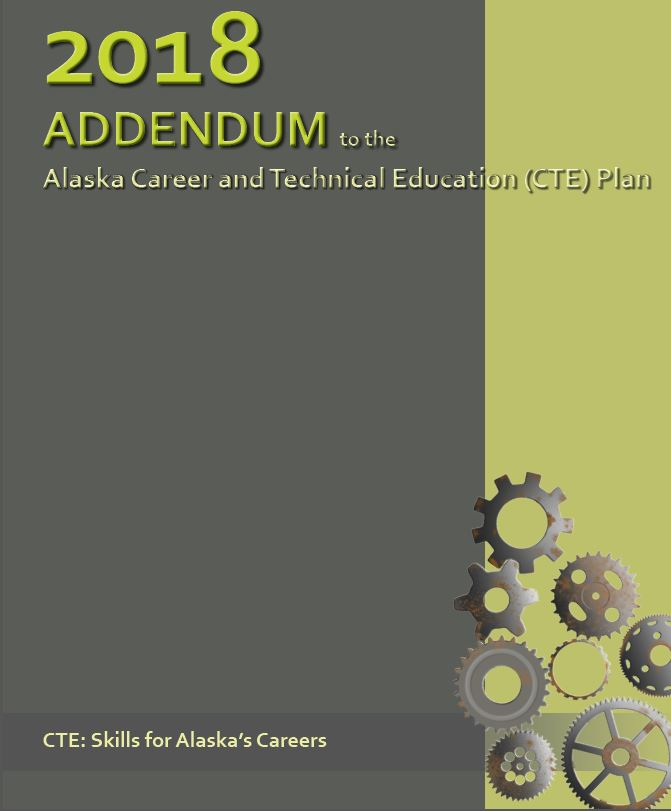
U.S. DEPARTMENT OF LABOR AWARDS ALASKA $3.35M TO PREPARE ALASKANS FOR WORK IN HIGH-GROWTH INDUSTRIES
JUNEAU, Alaska — The U.S. Department of Labor awarded $3.35 million dollars to the Alaska Department of Labor and Workforce Development in Trade and Economic Transition Dislocated Worker Grants. This two-year funding will expand the capacity of dislocated worker training and employment programs that prepare Alaskans for occupations in the state’s fastest growing sectors: health care, construction, and maritime industries.
“It is critical that we invest in Alaskans who seek training to be first in line for these high-paying jobs on major projects, such as the Alaska LNG Gasline,” said Alaska Governor Bill Walker. “This funding will assist as we grow our own skilled workforce to fill essential occupations; from welders and pipefitters, operating engineers, to truck drivers, laborers, electricians and mechanics.”
Dislocated Worker Grants support state, tribal, and non-profit entities that implement innovative skills training and career services for people seeking reemployment as the economy and corresponding workforce needs change. Alaska’s aging workforce will increase demand for qualified workers across all sectors, in addition to the growing number of jobs in health care, construction, and maritime industries. This funding will boost existing training and support services provided by the Department of Labor and Workforce Development’s Job Center Network.
“This funding supports our steadfast commitment to Alaska Hire and a robust, skilled workforce,” said Labor Commissioner Heidi Drygas. “It is critical that Alaskans who need to transition careers are ready to go to work in these high demand occupations, and the Department is eager to assist in that process.”
Grant funds will be available through the job centers for dislocated workers and will come in diverse forms, including:
Enhanced career services, support services and work-based learning opportunities
Training programs that lead to industry recognized credentials and employment
Quality pre-apprenticeship opportunities in health care and construction industry occupations
Support for those newly entering Registered Apprenticeships
Direct employment referral
For more information: Shawna Harper, Assistant Director of Workforce Development, Division of Employment and Training Services: 907-465-1882, Shawna.Harper@alaska.gov.
WEBINAR: THE STATE’S ROLE IN COMMUNICATING ABOUT CTE
Join Advance CTE on Thursday, September 20 from 2 – 3 p.m. ET for Advance CTE’s webinar, The State’s Role in Communicating About Career Technical Education (CTE). Advance CTE will feature Idaho Career and Technical Education and how they have transformed the way in which they communicate about CTE with all stakeholders. Caty Solace, Outreach and Communications Manager at the Idaho Workforce Development Council, will discuss how Idaho CTE created a statewide brand, introduced storytelling as a major component of their communications plan and the tactical strategies they used to better communicate about the value and promise of CTE across all audiences.
Speakers:
- Caty Solace, Outreach & Communications Manager, Idaho Workforce Development Council
- Katie Fitzgerald, Communications Manager, Advance CTE
CTE PRESIDENTIAL SCHOLARS AWARD APPLICATION
CTE Presidential Scholars Award
The program is open to all high school seniors who participate in a CTE program, who will graduate between January and June 2019, and who are U.S. citizens or legal permanent residents. Students at public, private, and home schools are eligible. This is not a scholarship program; it is a recognition program. Presidential Scholars will receive a medallion at an expenses-paid ceremony in Washington, D.C. The state may nominate up to five exemplary high school seniors. The Presidential Scholars will be chosen by a commission.
Applications are due by 4 p.m. November 1. Only two scholars per school may be nominated. See http://www2.ed.gov/programs/psp/faq.html#applications. The Alaska contact is Dr. Bjorn Wolter at 907-465-6542 and bjorn.wolter@alaska.gov
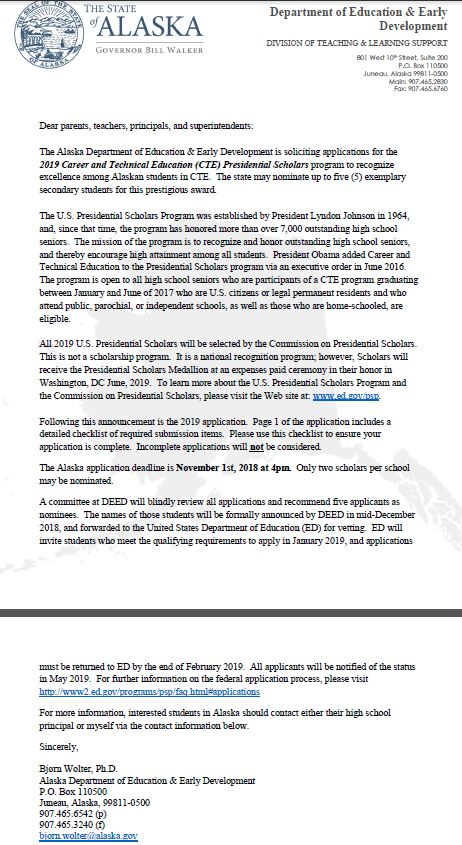
AVTEC’S YOUNG MARINER TRAINING PROGRAM 2018/2019 REGISTRATION OPENS
Interested in Earning your Professional Merchant Mariner Credentials Before HS Graduation?
AVTEC’s Young Mariner Program fast tracks high school students into a high paying, exciting maritime career without incurring any debt!
Students whom successfully complete this course have access to grant funding to pay tuition, room & board and US Coast Guard Credential fees for ALL AVTEC Maritime Training courses.
REGISTRATION IS OPEN and will close a week before class starts or as soon as fills. Don’t delay!
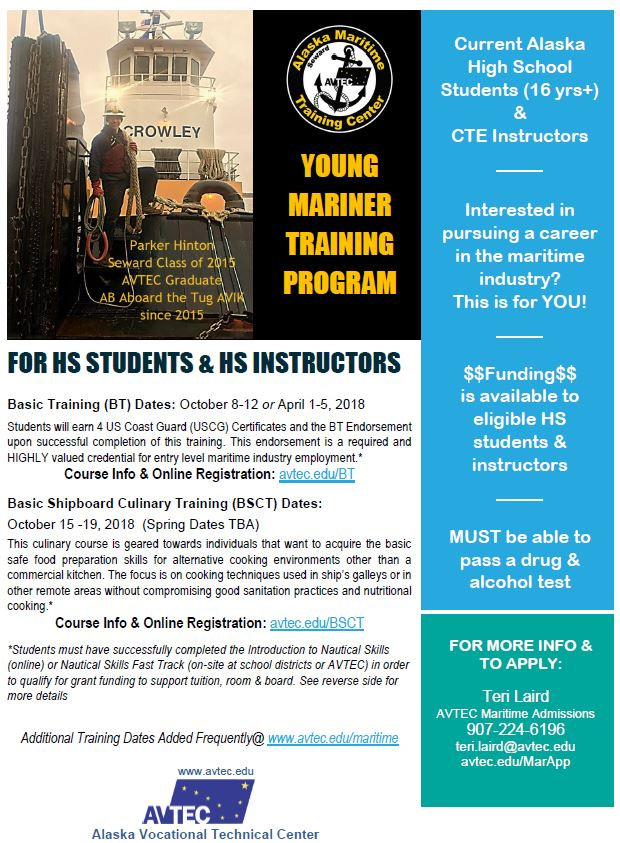
MARITIME WORKS HIGHLIGHTS CAREER INFORMATION
Maritime Works has created a webpage and downloadable flyers that highlight various maritime careers including fisheries; seafood harvesting; seafood processing technical and management; ship building, repair, and maintenance; and vessel operations.
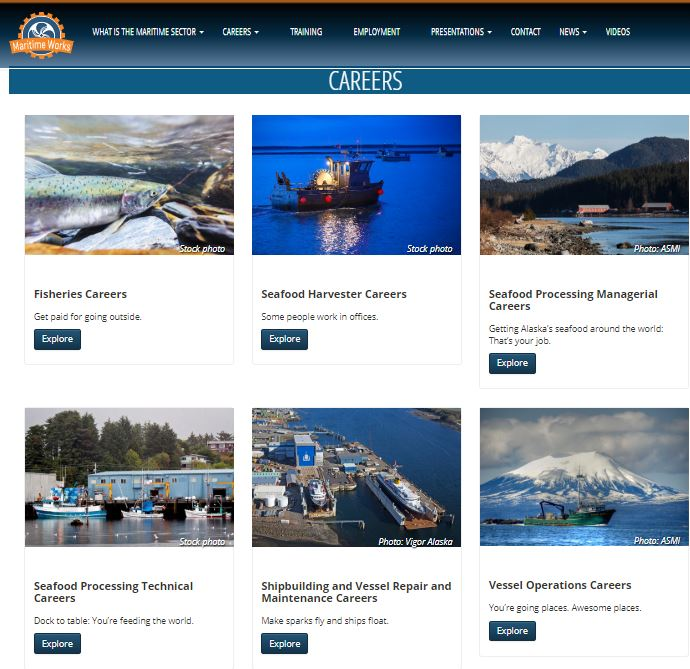
ALASKA AWARDED $1.2 MILLION TO EXPAND WORKFORCE OPPORTUNITIES FOR INDIVIDUALS AFFECTED BY THE OPIOID CRISIS
JUNEAU, Alaska – The U.S. Department of Labor has awarded a competitive grant of $1,263,194 to the Alaska Department of Labor and Workforce Development to provide training and upskilling to workers in professions that support individuals struggling with addiction and expand career opportunities for Alaskans affected by opioid use, addiction, and overdose.
The “Opioid Crisis Intervention and Community Involvement Project” is a two-year grant to improve employment opportunities and outcomes for individuals impacted by the effects of the opioid crisis. The department will partner with the Alaska Department of Education and Early Development, Division of Vocational Rehabilitation, Division of Juvenile Justice, community-based organizations, and health care providers to serve over 600 youth and adults across the state. The project will inform at-risk youth about the dangers of opioid addiction; increase training for behavior health care providers; provide employment supports and services for individuals impacted by the opioid crisis; support teachers through early intervention training; and supply health care partners with Bridge Auricular Stimulators to combat withdrawal symptoms.
“By targeting workforce training and services to those affected by opioids, this project supports Governor Walker’s focus on addressing this severe public health emergency in Alaska,” said Labor Commissioner Heidi Drygas. “We look forward to partnering with other agencies and with health care providers across the state to combat this crisis.”
On February 15, 2017, Governor Bill Walker declared Alaska’s opioid epidemic a public health crisis. This project, as one component of the Governor Walker’s “Safer Alaska” initiative, will bolster other response efforts throughout the state. The project builds upon existing supports and training services by creating new pathways to training opportunities, providing early intervention in communities, and upskilling health care workers to better serve individuals affected by the opioid epidemic.
NEW VIDEO FROM ADVANCE CTE
Advance CTE has released a new video (about 2.5 minutes long) to promote Career and Technical Education - entitled CTE 101. Please feel free to link to the video, post it directly on your CTE website, and show it at any career presentations you may be hosting or participating in.
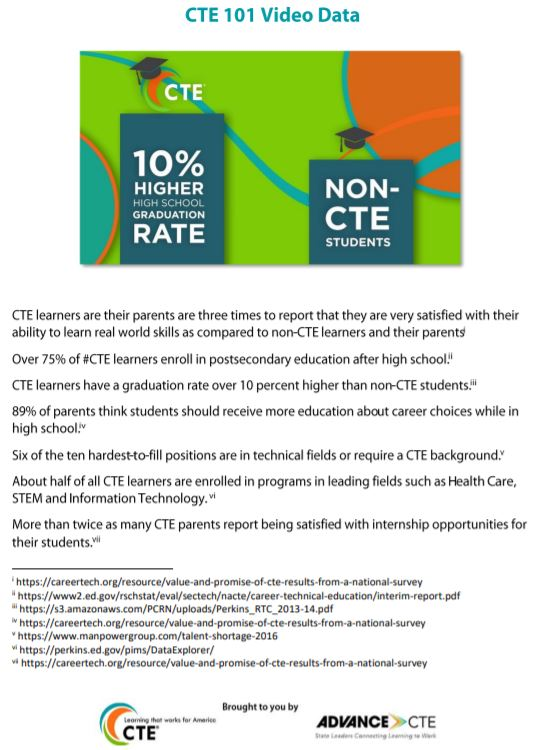
ALASKA LNG PROJECT GASLINE WORKFORCE PLAN
The Alaska Department of Labor and Workforce Development has just made its March 2018 Alaska LNG Project Gasline Workforce Plan available. Please visit this link to view or download the plan in PDF format.
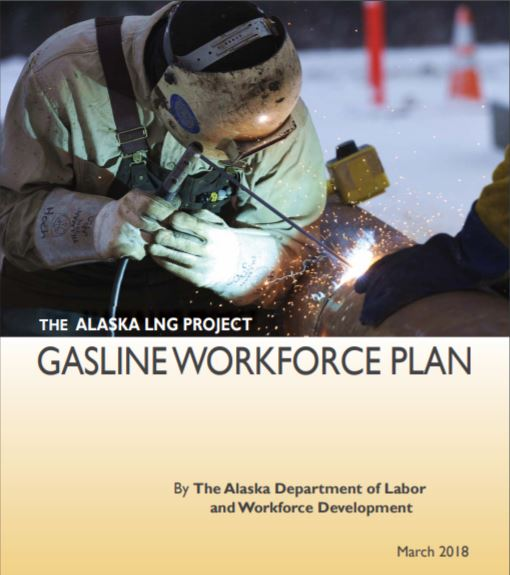
PLEASE GIVE YOUR FEEDBACK FOR CTE PLAN REVIEW!
We are asking for your feedback as we review the 2010 Alaska CTE Plan. Two surveys have been developed, a general CTE survey and a survey specific to those representing business and industry in Alaska. Please select the most fitting survey to complete.
CTE survey link
Business and Industry survey link
Please complete this survey by April 6, 2017. You are welcome to forward this message to others with an interest in career and technical education.
By participating in this brief survey, you can assist in efforts to improve Alaska’s career and technical education system and help ensure that Alaskans have the education and training to meet our state’s industry needs.
In 2009 the Department of Labor and Workforce Development (DOLWD), the Department of Education and Early Development (DEED), and the University of Alaska (UA) worked together to develop Alaska’s first plan for Career and Technical Education or CTE (formerly known as vocational education). This original plan, finalized in 2010, was developed in recognition of the need for a stronger system to meet both the educational needs of students and adults and the real needs of our workforce.
The Alaska Workforce Investment Board (AWIB), in coordination with DOLWD, DEED, and UA, has formed a Workgroup of board members and other education leaders to review Alaska’s 2010 Career and Technical Education (CTE) Plan and create an addendum to it. With this effort, the Workgroup intends to:
ignite dialogue around career and technical education,
examine the strategies outlined in the 2010 CTE plan, and
raise awareness of CTE and its important role in preparing Alaskans for both personal success and meeting our state’s workforce demands.
Knowing the importance of stakeholder input, the AWIB Workgroup is seeking feedback from a variety of stakeholders to ensure that their efforts result in an addendum document that is valuable and practical for the diverse workforce development community, including business and industry, students, and policy makers.
Please contact Allison if you have any questions about the survey or the AWIB Workgroup’s effort.
Allison Biastock
Executive Director, Alaska Workforce Investment Board
Department of Labor & Workforce Development
Phone: (907) 375-6407
UAA HOSTS FUN & FREE FINANCIAL LITERACY EVENT
In April, UAA will be helping to celebrate financial literacy month. To kick it off, the UAA Financial Aid Office will be hosting events around campus, including the Financial Literacy Resource Fair and Colin Ryan show on April 5. This is free and open to the community and would be great to encourage high school students (and their families) to attend.

ALASKA CAREER & TECHNICAL EDUCATION PROGRAM CONTACTS
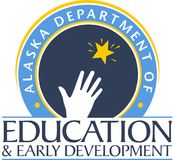
Alaska Department of Education & Early Development
Deb Riddle, Federal Programs Administrator
deborah.riddle@alaska.gov
http://education.alaska.gov/tls/CTE/
Phone 907-465-2892

Alaska Department of Labor and Workforce Development
Marcia Olson, Education Specialist
Marcia.Olson@Alaska.Gov
907-269-3018
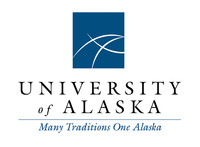
University of Alaska System
Fred Villa, Associate Vice President of Academic Affairs for Workforce Programs
FVilla@Alaska.Edu
www.alaska.edu/research/wp/
907-450-8008